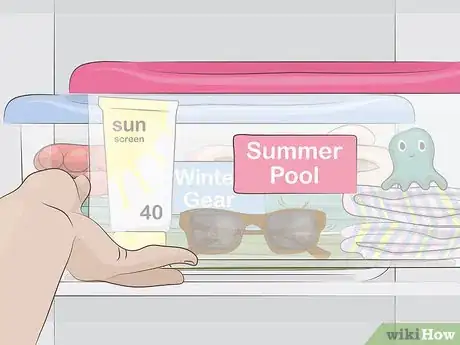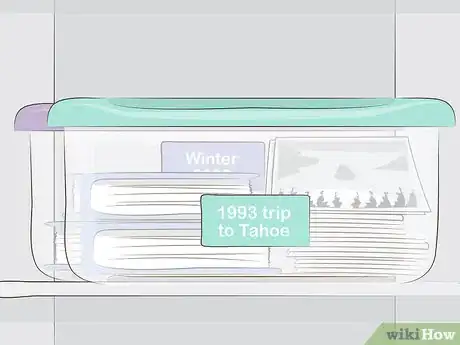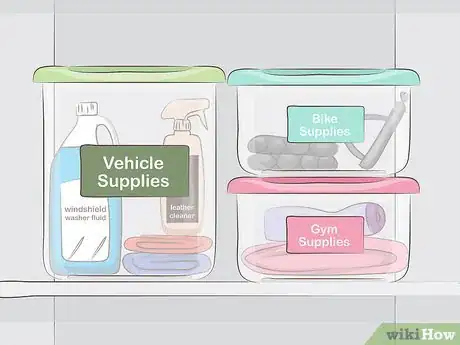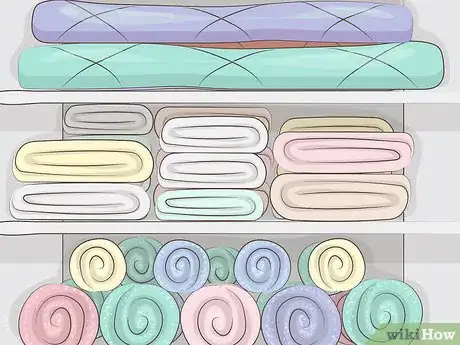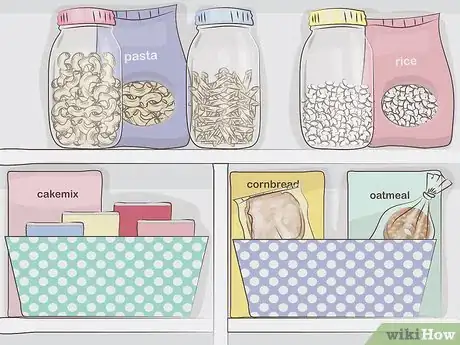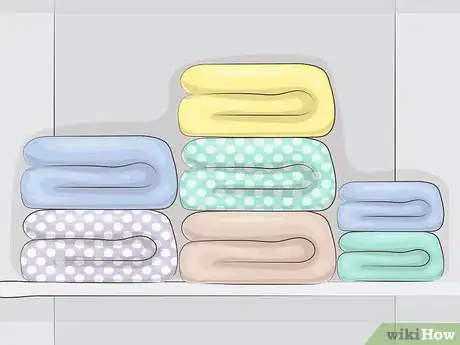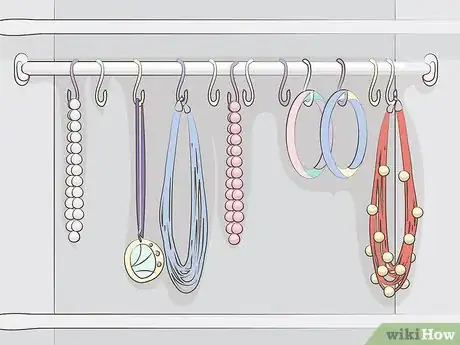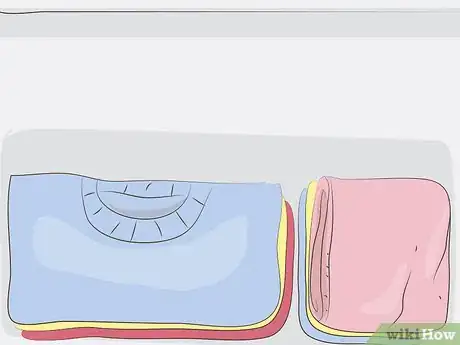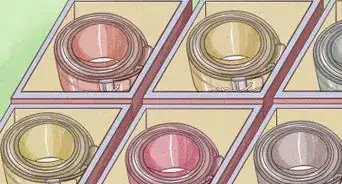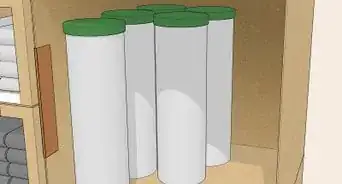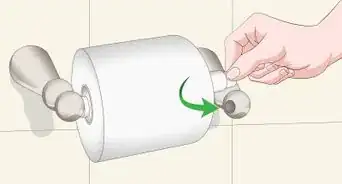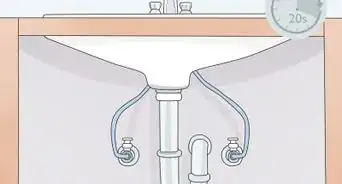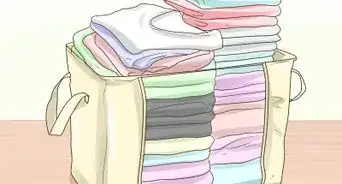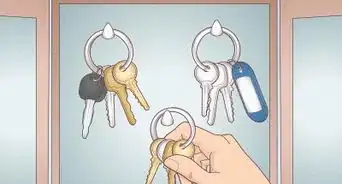This article was co-authored by Caitlin Jaymes. Caitlin Jaymes is a Closet Organizer and Fashion Stylist based in Los Angeles, California. With a background in Fashion PR and Fashion Design, she specializes in creating wardrobes for her clients with pieces they already own. She has experience working with celebrities, editorial shoots, and men and women of all ages. Caitlin uses fashion and organization to help instill and influence confidence, ambition, and stress-free lifestyles for all her clients. She runs her business by two guiding principles: “fashion has no rules, only guidance on how to look and feel your best” and “life has too many stressors, don’t let clutter be one of them.” Caitlin’s work has been featured on HGTV, The Rachael Ray Show, VoyageLA, Liverpool Los Angeles, and the Brother Snapchat Channel.
This article has been viewed 57,100 times.
Deep shelves in a bathroom or bedroom closet can be difficult to organize. It’s often impractical to remove items in the front in order to reach items in the rear, and yet it seems wasteful to leave the back of deep shelves empty. You can solve this problem through careful arrangement: organize the items in your closet in labeled plastic containers. It may help you to organize more effectively if you think of the front and back halves of the shelves as different spaces which you can organize separately.
Steps
Grouping Your Items
-
1Take everything out of the closet before reorganizing. Unpack the closet contents onto nearby counters or a section of the floor. Once everything has been pulled out of the closet, you can begin to plan what types of item you’d like to put on each closet shelf.
- Reorganizing deep closet shelves while they’re still full of items would be a difficult task.
-
2Re-organize seasonally to put less-used items farther back in the closet. A large, deep closet probably contains items used in each season. On each shelf, combine items that are used together in a specific season. So, as summer turns into fall, fill a small plastic container with your sunscreen, sunglasses, and small pool toys. Label this “Summer Pool,” and house it in the back of the closet.
- Or, if winter is over and spring has arrived, fill a plastic container with winter scarves, hats, gloves, and mittens. Label this “Winter Gear” and move it to the back of the closet while you’re getting out your “Spring” container.
EXPERT TIPCaitlin Jaymes is a Closet Organizer and Fashion Stylist based in Los Angeles, California. With a background in Fashion PR and Fashion Design, she specializes in creating wardrobes for her clients with pieces they already own. She has experience working with celebrities, editorial shoots, and men and women of all ages. Caitlin uses fashion and organization to help instill and influence confidence, ambition, and stress-free lifestyles for all her clients. She runs her business by two guiding principles: “fashion has no rules, only guidance on how to look and feel your best” and “life has too many stressors, don’t let clutter be one of them.” Caitlin’s work has been featured on HGTV, The Rachael Ray Show, VoyageLA, Liverpool Los Angeles, and the Brother Snapchat Channel.Professional Organizer
 Caitlin Jaymes
Caitlin Jaymes
Professional OrganizerOur Expert Agrees: When you're organizing your closet shelves, think about your lifestyle and the items you use more frequently. However, you should also consider what you really love, and put that toward the front of your closet. For instance, if you wear a suit to work every day but you really hate wearing a suit, you wouldn't necessarily put that at the front of your closet. You want to feel inspired and excited every time you go into your closet to get dressed.
Advertisement -
3Store boxes of photographs on their own shelf. If you have albums of physical printed photographs, store them in boxes on a shelf of your closet. The depth of the closet will work to your advantage in this instance: you can add additional boxes farther back in the closet as your printed photographs continue to accumulate.[1]
- Be sure to label the boxes so you know what photos are inside. For example, “Winter 2000” or “1993 trip to Tahoe.”
Organizing with Containers
-
1Organize items in labeled plastic containers. Use small plastic containers—each roughly 12 inches (30 cm) by 5 inches (13 cm)—to store related items in the closet. You can organize the plastic containers 2 or even 3 rows deep, and still remember where each type of item is stored. Once a container is full, label it using a piece of masking tape.[2]
- So, in a container labeled “Vehicle Supplies,” you could combine leather cleaner, oil, windshield washer fluid, and cleaning rags.
- If you were to put loose items into the back of a deep closet, they’d likely get lost over time or become impractically disorganized.
- You can purchase various sizes of plastic containers at a local home-supply store. Also check hobby shops or craft stores.
-
2Store food items in a wicker or canvas basket. If you’d prefer not to have food items loose on your pantry shelves, pick up a few decorative wicker baskets or canvas storage bins to store the items in. For example, one wicker basket could hold cans of nonperishable foods, while another could hold various loaves of bread and bags of bagels and English muffins.
- Wicker or canvas baskets don’t need to be labeled, since you can clearly see what’s in each basket.
-
3Store reserve toiletries and household supplies in a plastic container. Storing these items in your deep closet shelves will keep them out of the way most of the time, but they’ll still be easily accessible when you need them. You could have a container labeled “Toiletries” with extra toilet paper, cotton balls, Q-tips, spare toothbrushes, and toothpaste. Have a separate container labeled “Lightbulbs,” and fill it with spare bulbs for your lights.[3]
- If you have a large amount of toiletries and household supplies, you can use a larger plastic container. For example, home-supply stores sell containers that are roughly 2 feet (0.61 m) deep × 18 inches (46 cm) high × 1 foot (0.30 m) tall.
Arranging the Shelves
-
1Store frequently-used linens on the front half of shelves. For example, if you’re organizing deep shelves in a linen closet, try dedicating 1 shelf to blankets, 1 to sheets, and 1 to towels. Then, stack the blankets, sheets, and towels that you use most frequently on the front half of their respective shelves. Stack the blankets, sheets, and towels that you seldom use on the back half of each shelf.
- Even if you’re not using plastic containers to organize your deep shelves, you can still organize them to be tidy and efficient.
-
2Organize kitchen items on the front and back halves of shelves. When organizing a pantry or kitchen cabinet, store similar types of food on the same shelf. Dedicate 1 shelf to pasta and rice, 1 to breads, and 1 to snacks and canned goods. Place items that you’ll use more often at the front of the shelves, and items that you seldom cook with on the rear half of the shelves.
- So, the front half of a shelf could be filled with canned goods, rice, and pasta. The back half of the same shelf could contain oatmeal, grits, cornbread, and cake mixes.
-
3Roll and stack linens to fit more on a shelf. Linens, including bath and beach towels, quilts, and blankets, can be folded into thirds and rolled up. Then, stack 3 or 4 towels or quilts on top of each other on your closet shelves. Rolled and stacked linens will take up less space and look tidier than linens that have only been folded.
- Rolling linens will also make it easier to re-arrange linens seasonally. Each spring, move the heavy quilts and blankets to the back half of the deep closet shelf, and pull cotton sheets, light blankets, and beach towels to the front half of the shelves.
-
4Add a hanging rod to the closet. To free up shelf space in your closet, install a rod at the top of the closet. Use the rod to hang small items, including jewelry, shorts, and skirts. You can also drape seasonal items over the closet rod when needed, including winter gloves and scarves.
- Hanging rods can be purchased at most large hardware stores and at home-supply stores.
-
5Leave the back half of a shelf empty if you can’t fill it. People often feel anxious about filling every possible inch of a shelf, simply because it’s open storage space. However, there’s nothing wrong with leaving the back half of a shelf empty if you simply don’t have supplies to put on it.
- Or, deliberately leave half of a deep shelf empty. Use this space to store miscellaneous items that you don’t currently have a permanent storage space for.

